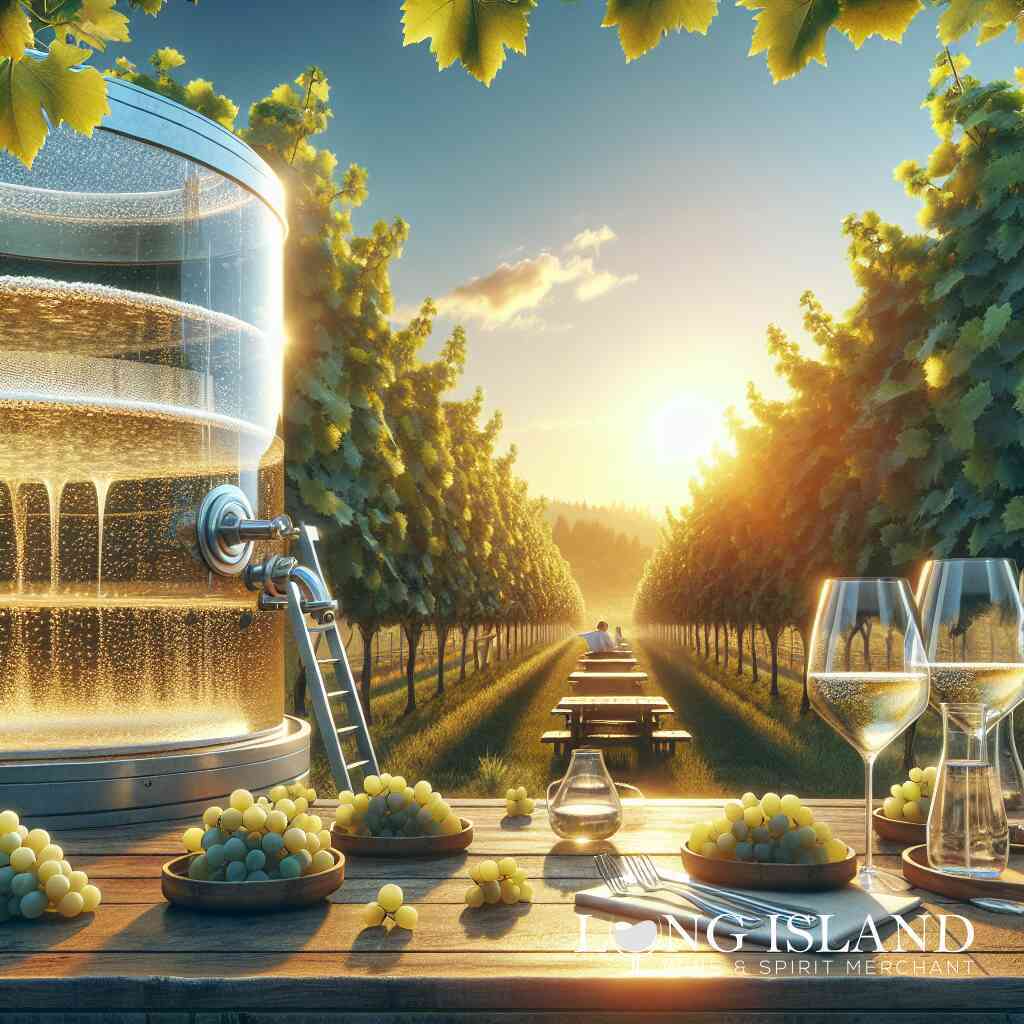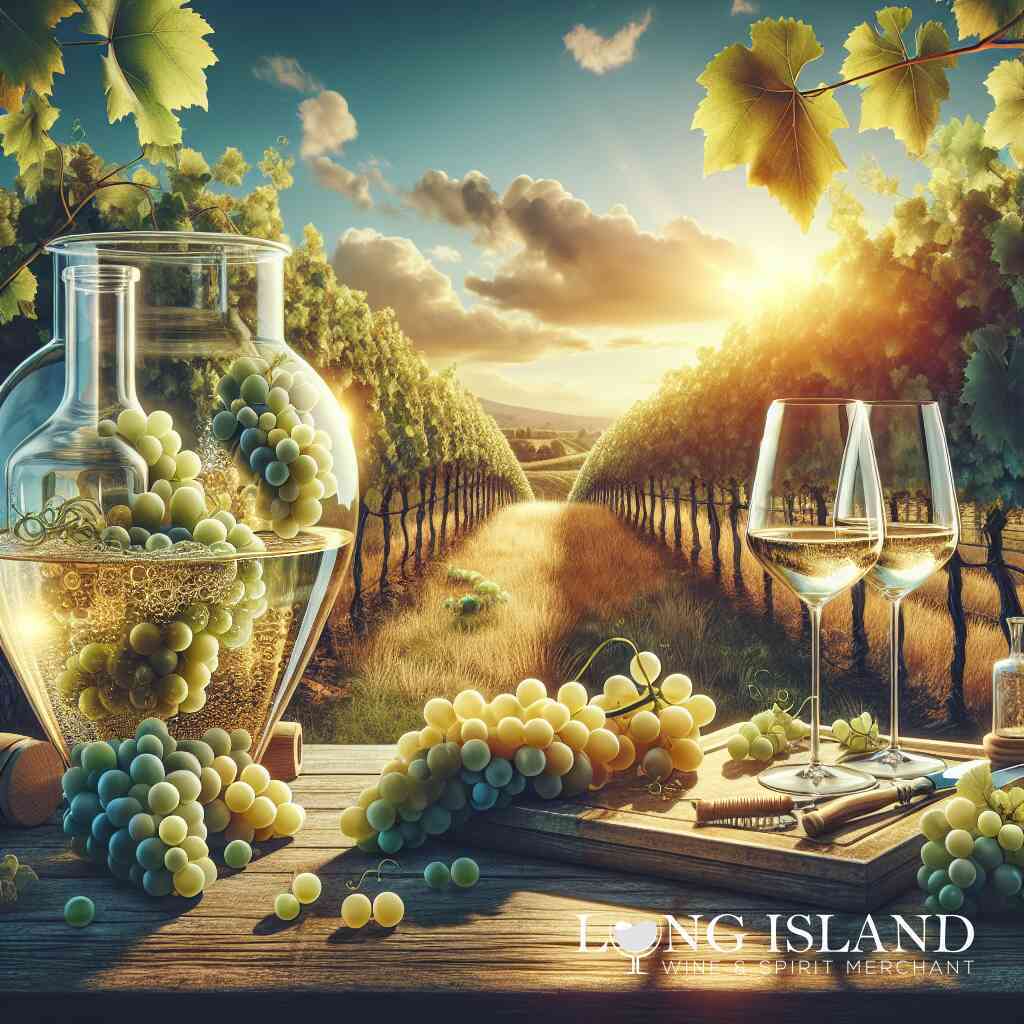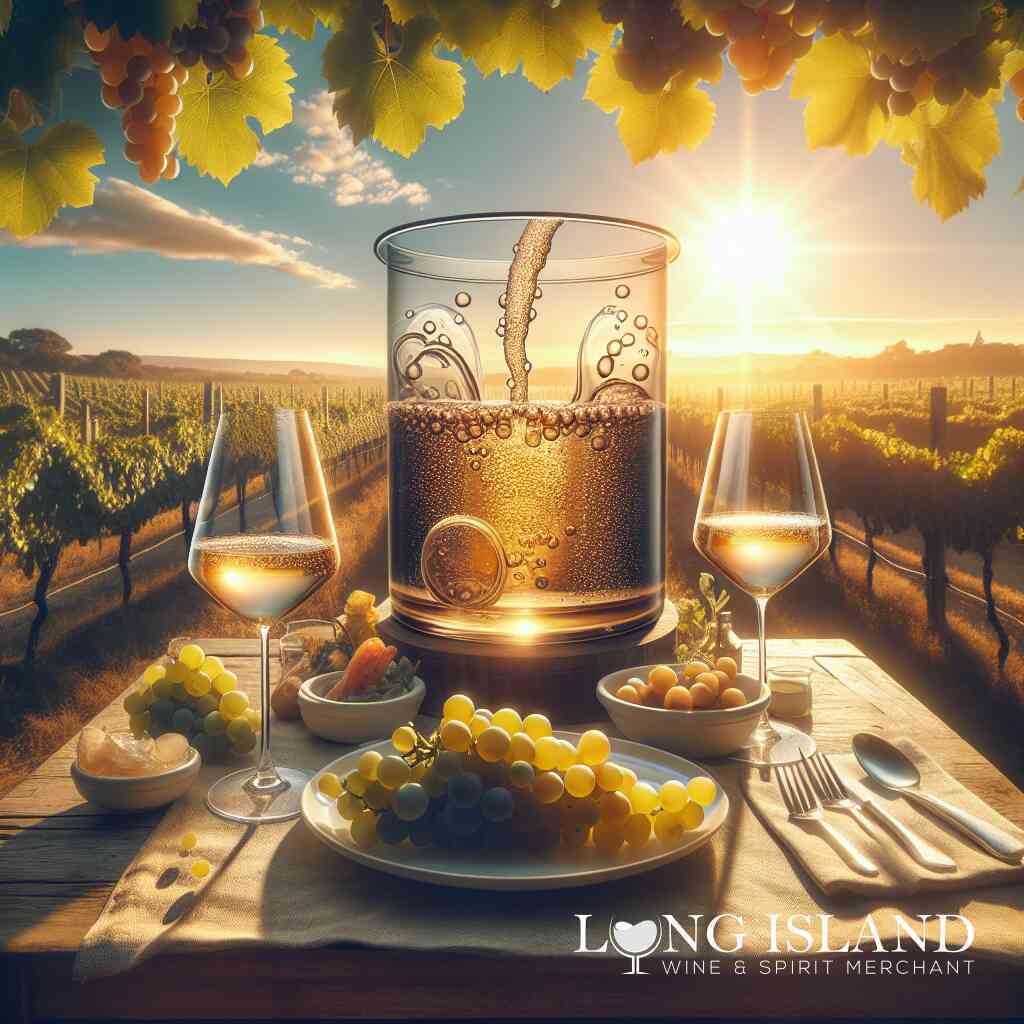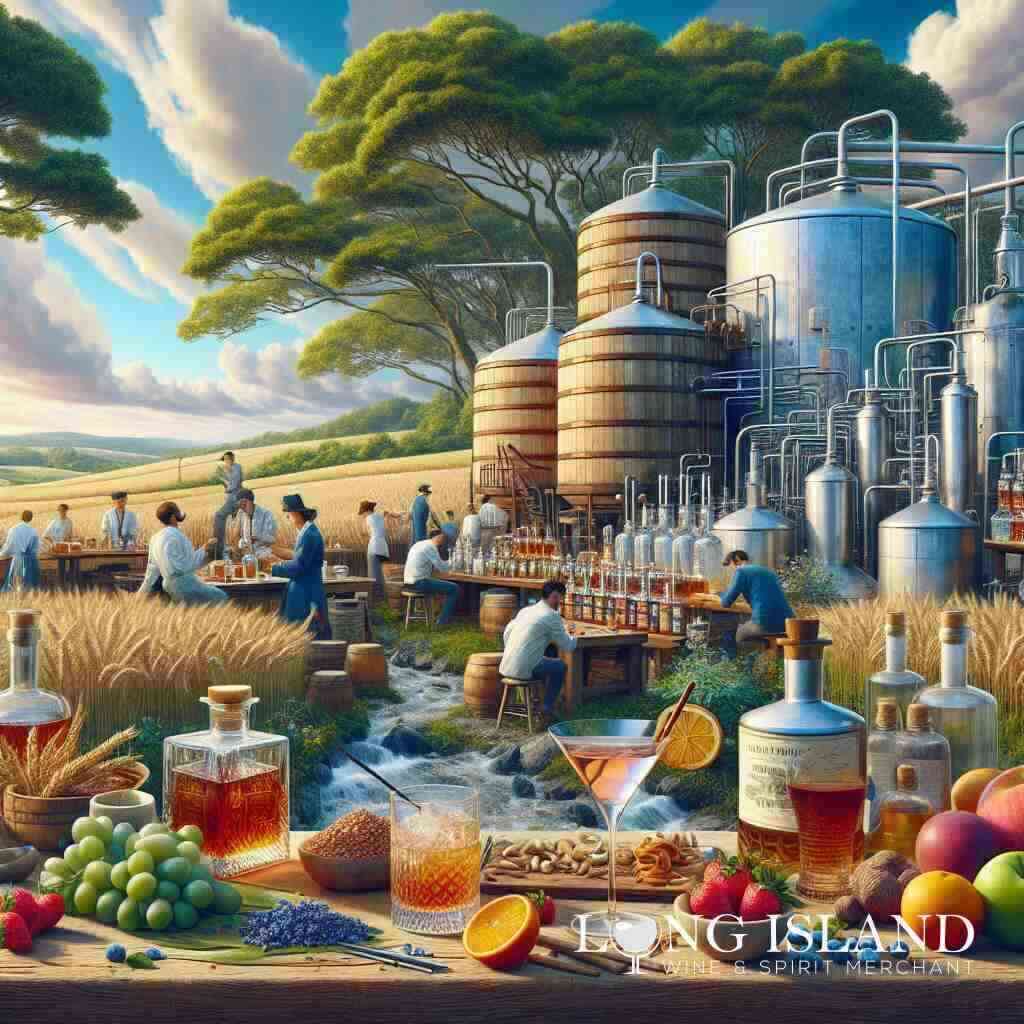
What is a Dry White Wine? Explanation & Fermentation Process
May 17, 2024
Introduction to the World of Dry White Wine
Defining Dry White Wine
Dry white wine is a popular choice among connoisseurs and casual drinkers alike, but what exactly makes a wine “dry”? The term refers to the absence of residual sugar in the wine, resulting in a lack of sweetness. During the fermentation process, yeasts consume the sugar present in grape juice and convert it to alcohol and carbon dioxide. In a dry wine, this process continues until most, if not all, of the sugar is consumed, leaving the wine with little to no perceptible sweetness. This characteristic makes dry white wines exceptionally versatile, pairing well with a wide range of foods and suitable for various occasions. Understanding the intricacies of dry white wine begins with recognizing its defining feature – its minimal sugar content, which sets the stage for a diverse array of flavors and aromas to shine through.
The Importance of Acidity in Dry White Wines
Acidity is a fundamental element in the taste profile of dry white wines, imparting a crispness and vibrancy that balances the flavors and contributes to the overall drinking experience. High levels of acidity can make a wine feel refreshing and light, while lower acidity levels tend to result in a richer, more rounded mouthfeel. The acidity in dry white wines plays a crucial role in their ability to pair with food, cutting through the richness of dishes and cleansing the palate between bites. Additionally, acidity is key to the aging potential of white wines, it acts as a preservative, allowing the wine to develop complexity over time. The interplay between dryness and acidity is what often defines the character and quality of a white wine, making it an essential aspect for enthusiasts and winemakers alike to understand.
Dry White Wine Varieties You Should Know
When exploring the diverse world of dry white wines, several key varieties stand out for their popularity, distinctive flavor profiles, and versatility. Sauvignon Blanc, for instance, is celebrated for its crisp acidity and vibrant citrus and herbal notes, making it a refreshing choice for warm weather. Chardonnay, another widely appreciated variety, can range from lean and mineral-driven to rich and buttery, depending on how it’s made. Riesling, though often associated with sweeter styles, also produces exceptional dry wines that showcase racy acidity and aromatic complexity. Other notable dry white wines include Pinot Grigio (or Pinot Gris), which offers a light, easy-drinking appeal, and Viognier, known for its lush floral aromas and soft palate. By exploring these and other varieties, wine lovers can discover the wide range of tastes and textures that dry white wines have to offer, each reflecting the unique terroir and winemaking practices of its region.
The Fermentation Process Unveiled
Understanding the Basics of Fermentation
Fermentation is the magical process that transforms grape juice into wine. At its core, fermentation involves yeast consuming the sugars found in grape juice and converting them into alcohol and carbon dioxide. This biochemical process is natural and has been harnessed by winemakers for thousands of years. The intricacies of fermentation can vary greatly depending on the types of grapes used, the specific strains of yeast involved, and the desired end product. For dry white wines, the goal is often to allow fermentation to proceed to its fullest extent, whereby the yeast consumes nearly all the sugar, leaving behind a wine with minimal residual sweetness. This fully fermented style results in a wine that is perceived as dry to the taste. Understanding the basics of fermentation provides a foundation for appreciating the craft and science that goes into producing each bottle of wine, highlighting the importance of this process in the creation of fine wine and good spirits.
How Sugar Content Affects Dryness
The sugar content in the grape juice at the beginning of fermentation directly influences the dryness of the final wine. Grapes harvested at higher levels of ripeness contain more sugar, which can potentially be converted into higher alcohol levels if the fermentation is allowed to run its course. For a wine to be considered dry, the yeast must consume a vast majority of this sugar, leaving less than 1% of residual sugar in the finished product. The winemaker’s control over the fermentation process, including temperature regulation and the selection of yeast strain, plays a critical role in dictating the wine’s final sugar content and, consequently, its dryness. This meticulous balancing act ensures that each varietal expresses its unique character while maintaining the desired dry profile that many wine enthusiasts seek.
The Role of Wine Yeast in Fermentation
Wine yeast is the unsung hero of winemaking, catalyzing fermentation. There are numerous strains of yeast, each imparting different characteristics to the wine, including variations in flavor, aroma, and texture. Selecting the appropriate yeast strain is a critical decision for winemakers, as it can significantly affect the wine’s quality and style. For dry white wines, winemakers often choose yeast strains that are efficient sugar consumers, ensuring that fermentation progresses to a point where little to no residual sugar remains. Moreover, some yeasts also contribute to the wine’s complexity by releasing compounds that add subtle flavors and aromas during the fermentation process. Understanding the pivotal role of wine yeast in fermentation not only underscores the scientific aspect of winemaking but also the artistry involved in crafting wines that capture the essence of their origin and the vision of their creators.
Exploring Dry White Wine Selections at Long Island Wine & Spirit Merchant
Curating Your Wine Rack with Our White Wines
When it’s about enhancing your collection or curating your wine rack, Long Island Wine & Spirit Merchant stands as your premier destination. Our selection transcends the basics of white wine, diving into not only the classics but also unique finds that embody the essence and diversity of global and Long Island wine landscapes. Every bottle on our rack is a testament to quality and variety, chosen to ensure that your wine glass mirrors your taste and the luxury of fine wine and good spirits. Whether you’re hosting a dinner party or savoring a quiet evening, our carefully selected dry white wines, from the crisp Sauvignon Blanc to the elegant Chardonnay, promise to elevate any occasion. Our expert team is dedicated to guiding you through our extensive selection, making personalized recommendations that resonate with your preferences, and enhancing your wine education.
Our Wine Tasting Events: An Opportunity to Discover
Long Island Wine & Spirit Merchant is not just about selling bottles, it’s about creating experiences and expanding palates. Our wine-tasting events are thoughtfully designed to immerse you in the world of wine, offering a splendid opportunity to explore the vastness of dry white wine varieties alongside other wine enthusiasts. These events are gateways to discovery, allowing you to savor and compare the subtleties between different regions, grapes, and winemaking techniques. Participants leave not only with a fuller understanding of what defines and distinguishes dry white wines but also with the joy of having found new favorites to add to their collections. Keep an eye on our website for upcoming events and make sure to reserve your spot for an enriching experience that promises to delight your senses and deepen your appreciation for fine wines.
Exclusive Long Island Artisan White Wines
In a nod to the rich viticulture of our region, Long Island Wine & Spirit Merchant proudly showcases an exclusive collection of Long Island artisan white wines. These selections celebrate the local terroir, featuring the work of skilled winemakers who aim to express the unique characteristics of our Long Island vineyards. By focusing on small-batch production and sustainable practices, these artisans create wines that are not only beautiful expressions of the grape but also eco-friendly and reflective of the area’s wine-growing heritage. From vibrant and zesty to rich and complex, our Long Island artisan selections offer a taste of the unique flavors and stories our region has to offer. Whether you’re a seasoned collector or new to the wine world, exploring these local treasures is an exciting way to support and enjoy the bounty of Long Island’s wine country.

Food Pairing with Dry White Wine
Basic Rules of Wine and Food Pairing
The art of pairing food with wine is about balancing flavors to enhance the dining experience. For dry white wines, the acidity, aroma, and body of the wine play crucial roles in determining which foods will pair well. A basic rule is to match the weight of the wine with the weight of the food. Lighter, crisp wines like Sauvignon Blanc pair well with salads, light fish dishes, and tart dressings or sauces. Richer whites like oaked Chardonnay, complement creamier, heavier dishes, such as chicken in a creamy sauce or lobster bisque. Acidity in wine can cut through richness and cleanse the palate, making high-acid wines excellent with fatty foods or dishes with a heavy cream base. Understanding these fundamental principles opens up a world of successful food and wine pairing opportunities.
The Best Foods to Complement Dry White Wines
Dry white wines offer a spectrum of flavors that can complement a wide array of dishes. For seafood lovers, crisp, mineral-driven whites such as Pinot Grigio are perfect with shellfish, oysters, or light fish dishes, enhancing the delicate flavors of the sea. Vegetarian dishes or salads with vinaigrette dressing pair beautifully with acidic, zesty wines like Sauvignon Blanc, which can highlight the freshness of the vegetables. For those enjoying poultry or pork, a medium-bodied Chardonnay provides enough weight and complexity to stand up to these richer meats without overpowering them. Spicy Asian or Latin dishes can benefit from the subtle sweetness and acidity of a dry Riesling, which helps to balance the heat and complex flavors of the cuisine. By selecting a wine that complements the primary elements of a dish, you can elevate the overall tasting experience.
Experimenting with Flavors: A Guide
The joy of wine pairing lies in experimentation and the discovery of personal preferences. It’s encouraged to mix and match different dry white wines with a variety of dishes to find the combinations that work best for you. Start with a wine that you enjoy on its own, then consider the dominant flavors in your dish-be they spicy, acidic, fatty, or sweet. Aim to either complement or contrast these flavors with your wine selection. For instance, a buttery Chardonnay can either complement a rich, creamy pasta or contrast nicely with a tart, citrus-based sauce. Remember that the goal is to enhance both the food and the wine, creating a harmonious balance that delights the senses. Don’t be afraid to break the traditional rules of pairing, sometimes, the most unexpected combinations can be the most rewarding. Websites like Long Island Wine & Spirit Merchant offer guides and tasting events that can inspire and educate, making the exploration of food and wine pairings an exciting and enjoyable journey.
Wine Education: Enhancing Your Understanding of Dry White Wines
The Science Behind Wine Acidity and Sugar Content
The journey into the world of dry white wines is both fascinating and complex, rooted deeply in the science of winemaking. At the heart of this science is the intricate balance between acidity and sugar content, elements that fundamentally shape the wine’s flavor profile and overall character. Acidity, a natural component of grapes, lends the wine its tartness and zest, acting as a preservative and enhancing its longevity. Sugar content, on the other hand, results from the natural sweetness of the grapes and the extent to which it is converted into alcohol during the fermentation process.
Understanding the interplay between these two components requires a basic knowledge of wine chemistry. During fermentation, yeasts convert grape sugars into alcohol and carbon dioxide. In dry white wines, this process continues until most sugars are converted, resulting in a wine with minimal residual sugar and a noticeably dry taste. The acidity of the wine, not to be overshadowed, plays a critical role in balancing the flavors, ensuring that the wine remains crisp and refreshing rather than flat or overly alcoholic. This delicate balance is what winemakers strive to achieve, and it greatly influences the wine’s pairing potential with food, its aging process, and ultimately, the drinker’s enjoyment.
Wine Serving Tips: Temperature and Glassware
Serving wine, especially fine dry white wine is an art that, when done correctly, can significantly enhance the wine-tasting experience. Temperature and glassware are pivotal factors that can influence the wine’s aroma, taste, and overall perception. Dry white wines, such as Sauvignon Blanc, Chardonnay, or Riesling, are best served chilled, generally between 45°F to 50°F (7°C to 10°C). This temperature range helps to preserve the wine’s delicate floral and fruity aromas while maintaining its refreshing acidity.
Choosing the right glassware is equally important. White wine glasses are typically smaller than red wine glasses, with a more U-shaped bowl that tapers towards the rim. This design aims to concentrate and deliver the wine’s aroma to the nose while directing the wine to the front of the palate, where its acidity can be best appreciated. Proper glassware not only elevates the wine but also enhances the drinker’s sensory experience, making every sip a journey of discovery.
Taking our Wine Taste Quiz in Long Island could provide personalized recommendations on which dry white wines might best match your preferences, ensuring that your serving choices are always spot on.
Wine Tasting Techniques for Evaluating Dry White Wine
Wine tasting is more than just drinking, it’s an evaluation technique that helps enthusiasts and professionals alike decipher the complexities and nuances of a wine. When it comes to dry white wines, certain tasting techniques can amplify your appreciation and understanding of what makes each bottle unique. First, observe the wine’s color and clarity by tilting the glass against a white background. A dry white wine’s color can range from pale yellow to deep gold, offering initial clues about its age and characteristics.
Swirling the wine gently in the glass introduces oxygen, which releases its aromatic compounds. Take a moment to inhale deeply and identify the range of scents, from floral and citrus to herbal and mineral notes. When tasting, take a small sip and let it linger on your palate, noting the wine’s acidity, body, and texture. Dry white wines should feel crisp, with a clean, refreshing finish that may reveal subtle complexities not initially apparent on the nose.
Finally, consider the wine’s aftertaste or finish. High-quality dry whites leave a lasting impression, with flavors that persist pleasantly after the wine is gone. By adopting these techniques, wine lovers can cultivate a deeper appreciation and understanding of dry white wines, unraveling the stories and craftsmanship behind every bottle.
Gifting and Wine Selection: Personalize Your Wine Experience
Building a Custom Case of Wine for Special Occasions
The art of selecting wine for special occasions is akin to curating a gallery of fine art. Each bottle tells a story, evokes a mood, and creates memories. At Long Island Wine & Spirit Merchant, we understand the significance of these moments. That’s why we offer the opportunity to build a Custom Case of Wine online, providing a personalized wine selection for any event, be it a wedding, anniversary, or festive gathering. With a wide range of Long Island wines and spirits, including the finest dry white wines, our guide assists you in choosing wines that not only reflect the occasion’s spirit but also your taste. Whether you prefer the crispness of a Sauvignon Blanc or the subtlety of a Chardonnay, our custom case service ensures your celebration is uniquely catered to the tastes and preferences of you and your guests.
Choosing the Perfect Wine Gift Box
The presentation of a wine gift can profoundly impact its reception. A carefully selected wine becomes a treasure when paired with the elegance of a gift box. Long Island Wine & Spirit Merchant takes pride in offering exquisite Wine Gift Boxes for any bottle of wine. These gift boxes transform a simple offering into a statement of sophistication and thoughtfulness. Ideal for corporate gifts, birthdays, anniversaries, or as a thank-you token, each box we provide is designed to enhance the overall gifting experience. In addition, we offer specialty services like wine bottle engraving, adding a personal touch that guarantees your gift will be cherished and remembered. Whether you choose a lush Marsala wine, an aromatic Caymus, or a refreshing Moscato, encasing it in a wine gift box elevates your present, making it as memorable as the wine inside.
Taking Our Wine Taste Quiz to Find Your Perfect Dry White Wine
Embarking on the journey to discover your perfect wine can be both exciting and daunting. Long Island Wine & Spirit Merchant has devised a solution to navigate the vast world of wine with ease – our Wine Taste Quiz. This innovative tool is specially designed to align with your preferences, guiding you to discover wines that resonate with your palate. For enthusiasts of dry white wine, the quiz is a golden opportunity to explore and refine your tastes. By answering a series of curated questions, the quiz reveals wines that match your flavor preferences and drinking habits. Whether you are drawn to the aromatic complexity of a Viognier or the crisp acidity of a Pinot Grigio, taking our Wine Taste Quiz is the first step towards uncovering wines that will captivate your senses and enhance your dining experience. With Long Island Wine & Spirit Merchant’s expertly selected inventory, your perfect wine awaits.

Conclusion: Expanding Your Wine Horizons with Dry White Wine
The Journey to Understanding Dry White Wine
The exploration of dry white wine is an enriching journey that deepens one’s appreciation for winemaking’s art and science. This excursion into the world of wine is not just about tasting, it’s an educational pathway where each bottle opened and every glass poured presents an opportunity to learn about different wine cultures, grapes, and the intricate processes behind fermentation. By diving into the vast expanse of dry white wines, from the crisp and invigorating Sauvignon Blanc to the complex and layered Chardonnay, wine enthusiasts can develop a more sophisticated palate and a deeper understanding of how factors such as terroir, winemaking techniques, and grape varieties influence the final product. Wine lovers are encouraged to continue exploring and sampling various white wines, deepening their knowledge and, in turn, their enjoyment of this delightful beverage.
Why Choose Long Island Wine & Spirit Merchant for Your Wine Needs
Long Island Wine & Spirit Merchant stands as a beacon for wine aficionados and novices alike, offering an unparalleled selection of fine wines and good spirits tailored to every taste and occasion. Our commitment to quality and selection is evident in every bottle that graces our shelves, from locally sourced Long Island wines to rare finds from across the globe. With a deep-rooted knowledge of Long Island wine, customers can trust our expertise to guide them through their vinicultural journey, whether they are seeking to expand their cellar collections, find the perfect gift, or simply enjoy a glass of wine that perfectly fits their mood. Our personalized services, including tailored wine recommendations and meticulously curated wine events, provide a unique and engaging experience that goes beyond the typical liquor store offering. Choosing Long Island Wine & Spirit Merchant means opting for a partner in your wine discovery journey, one that is committed to enriching your wine experience at every turn.
Next Steps: Visiting Our Store or Exploring Alcohol Delivery Options
Embracing the world of wines, especially dry white wines, is a journey best embarked upon with a reliable guide. Long Island Wine & Spirit Merchant encourages wine enthusiasts and curious beginners to visit our store in Commack, New York, or explore our extensive collection online. Our user-friendly website makes it easy to Order Alcohol online in Long Island, including local delivery options that bring the finest selection of wines and spirits directly to your door. Whether you’re building your home wine collection, searching for the perfect wine gift, or simply wishing to indulge in a new wine experience, our range of services caters to all your needs. Discover the ease of exploring the world of wine from your own home or by visiting us in person for a personalized shopping experience. Let Long Island Wine & Spirit Merchant be your guide as you expand your wine horizons and explore the rich, diverse tapestry of dry white wines.
Frequently Asked Questions
Question: How does Long Island Wine & Spirit Merchant ensure the quality of its dry white wine selection?
Answer: At Long Island Wine & Spirit Merchant, we pride ourselves on our meticulous selection process, ensuring each bottle of dry white wine we offer meets superior quality standards. Our experts meticulously taste and curate our selection from both local Long Island vineyards and globally acclaimed wine regions, focusing on the wine’s fermentation process, flavor profile, and the craftsmanship behind it. With our dedication to fine wine and good spirits, customers can trust that they are receiving only the best wines, characterized by their delightful bouquets, crisp acidity, and rich stories of their origins.
Question: Can you explain the fermentation process mentioned in “What is a Dry White Wine? Explanation & Fermentation Process” and how it affects the dryness of white wines?
Answer: Absolutely! The fermentation process is key to producing dry white wine, involving the conversion of sugar in grape juice into alcohol and carbon dioxide by yeasts. In dry white wines, this process continues until almost all the sugar is consumed, leaving the wine with less than 1% residual sugar, which is hardly detectable to the palate. This lack of sugar accentuates the wine’s natural flavors and acidity, giving dry white wines their characteristically crisp and refreshing profile. At Long Island Wine & Spirit Merchant, we value this intricate process and offer a diverse selection of wines that showcase the mastery of wine fermentation, ensuring our customers experience the full spectrum of dry white wine’s complexity and enjoyment.
Question: How can I learn more about wine tasting and wine selection through Long Island Wine & Spirit Merchant?
Answer: At Long Island Wine & Spirit Merchant, we’re passionate about expanding your wine horizons and offering enriching wine education experiences. Our wine-tasting events on Long Island provide the perfect opportunity to learn more about dry white wines, various wine and food pairings, and the fascinating winemaking process. Our expert team is always ready to share their knowledge, guiding you through our wine selection and helping you discover wines that resonate with your palate. Additionally, our Wine Taste Quiz online is a fantastic starting point for anyone looking to personalize their wine exploration journey and find their perfect wine match among our extensive selection of fine wines and good spirits.
Question: What are some ideal food pairings for dry white wines available at Long Island Wine & Spirit Merchant?
Answer: Dry white wines possess a versatility that makes them an excellent match for a broad array of dishes. At Long Island Wine & Spirit Merchant, our selection includes wines perfect for coupling with seafood, such as crisp and mineral-driven Pinot Grigio, which complements shellfish beautifully. For a tantalizing contrast with spicy dishes, a dry Riesling with its subtle sweetness and robust acidity is ideal. Rich, creamy sauces and poultry dishes pair wonderfully with a full-bodied Chardonnay, enriching the dining experience. Our knowledgeable staff can offer personalized recommendations, ensuring your wine selection elevates any meal from ordinary to extraordinary.
Question: Can Long Island Wine & Spirit Merchant assist in selecting a custom case of wine for a special event?
Answer: Certainly! Long Island Wine & Spirit Merchant excels in curating custom cases of wine tailored to special occasions. Whether celebrating a wedding, or anniversary, or hosting a sophisticated gathering, our team is adept at selecting wines that not only cater to the event’s theme but also to your tastes. Our expertise in making Mother’s Day Special with the Mother’s Day Wine Case can help tailor the perfect wine selections for your special events. Drawing from our vast selection of Long Island wines and global finds, we can assemble a case that promises to captivate and enchant your guests. Our commitment to quality, variety, and personalized service ensures your special occasion is complemented with the perfect wine selection.



